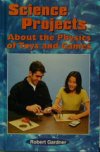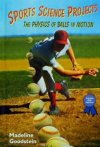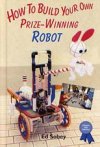Spin, Splat, and Scramble Additional Information
To do an experiment to learn more about curveballs in baseball and the Magnus effect, see http://www.sciencenewsforkids.org/articles/20040121/LabZone.asp.
For additional information on the Intel International Science and Engineering Fair, go to http://www.sciserv.org/isef/ (Science Service).
You can play with a Rubik’s Cube at www.surfnetkids.com/games/rubik.htm (Surfing the Net with Kids) or www.woodlands-junior.kent.sch.uk/Games/lengame/rubik/index.html (Woodlands Junior School, Kent, England). The official Rubik’s Cube Web site is at dev.rubiks.com/ (Rubik’s Cube).
Books recommended by SearchIt!Science:
 |
Science Projects About the Physics of Toys and Games — Robert Gardner
Published by Enslow Publishers, 2000.
This book is about the physics involved with things like toy cars, balloons, and even toys that you make. It’s packed with dozens of step-by-step experiments and activities that you can perform yourself. Each one includes an introduction to the subject, safety hints, a list of scientific equipment suppliers, and an index. Gardner also marks the experiments that he thinks would make good science fair projects. Experiments include “Make a Comeback Toy”, “Make a Toy Electric Motor”, “How Does a Push-N-Go Toy Work?” and “Walking on Snow.” |
 |
Sports Science Projects: Physics of Balls in Motion — Madeline Goodstein
Published by Enslow Publishers, 1999.
Physics involves the study of motion, speed, and interaction between objects—how things work, in other words. This book looks at the physics of balls: why and how they bounce, how they travel the farthest, what happens when they spin, and so on. The experiments in this book will help you answer questions such as why golfers needs so many clubs, why backspin helps you make a basket, and why footballs bounce the way they do. |
 |
How To Build Your Own Prize-Winning Robot — Ed Sobey
Published by Enslow Publishers, 2002.
Can you design and build your own robot? Sure you can—and this ractical book will show you how! (It will help if you have tools and materials such as servos, wheels, wire cutters, circuit boards, a computer, and a voltmeter). The first chapter offers a general introduction to robots and gives you instructions on how to build a motorized model car or boat. Electric motors are explained in the second chapter, which teaches you about selecting motors and voltage. Modifying servo motors, attaching wheels, selecting your robot platform, providing electrical power, and controlling your robot’s motion are discussed in the subsequent chapters. The final two chapters offer suggestions about how to make your robot do more through electronics and how to apply your robot-building skills to science fairs and robot contests. |
Power Words
lift A force that pushes an object upward against the pull of gravity. Lift can be created by a gas that weighs less than air, such as helium in a balloon. It can also be created when the air pressure above an object is less than the air pressure below it, as when an airplane wing moves through the air.
Copyright © 2002, 2003 Houghton-Mifflin Company. All rights reserved. Used with permission.
